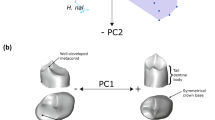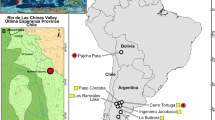Abstract
WE report here the discovery of a Miocene hominoid from Berg Aukas, Namibia, the first known from the African continent south of equatorial East Africa. This represents a major range extension of Miocene Hominoidea in Africa to latitude 20° S. The holotype, a right mandibular corpus preserving the crowns of the P4–M3, partial crown and root of the P3, partial root of the canine, alveoli for all four incisors, and partial alveolus for the left canine, was found during paleontological explorations of karst-fill breccias in the Otavi region of northern Namibia. The mandible has unique characteristics that differentiate it from other middle Miocene hominoids of Africa and Eurasia and represents the only fossil evidence documenting a pre-australopithecine stage of hominoid evolution in southern Africa. Faunal analyses indicate that the breccia block containing the specimen accumulated during the latter part of the middle Miocene, about 13 ± 1 Myr. Fauna from other breccia blocks at Berg Aukas are of diverse ages, including the earlier part of the middle Miocene, the upper Miocene, Plio-Pleistocene and Holocene.
This is a preview of subscription content, access via your institution
Access options
Subscribe to this journal
Receive 51 print issues and online access
$199.00 per year
only $3.90 per issue
Buy this article
- Purchase on Springer Link
- Instant access to full article PDF
Prices may be subject to local taxes which are calculated during checkout
Similar content being viewed by others
References
Alpagut, B., Andrews, P. & Martin, L. J. hum. Evol. 19, 397–422 (1990).
Conroy, G. C. Palaeont. afr. 28, 53–58 (1991).
Keene, H. J. Am. J. phys. Anthropol. 25, 208–209 (1966).
Harrison, T. Folia Primatol. 50, 59–108 (1988).
Leakey, R. E. & Leakey, M. G. J. hum. Evol. 16, 369–387 (1987).
Andrews, P. Bull. Br. Mus. nat. Hist. 30, 85–224 (1978).
Andrews, P. in Ancestors: The Hard Evidence (ed. Delson, E.) 14–22 (1985).
Andrews, P. J. & Martin, L. B. J. hum. Evol. 16, 101–118 (1987).
Leakey, R. E., Leakey, M. G. & Walker, A. C. Am. J. phys. Anthropol. 76, 277–288 (1988).
Leakey, R. E., Leakey, M. G. & Walker, A. C. Am. J. phys. Anthropol. 76, 289–307 (1988).
Harrison, T. Am. J. phys. Anthropol. 71, 265–284 (1986).
Harrison, T., Delson, E. & Jian, G. J. hum. Evol. 21, 329–362 (1991).
Ginsburg, L. in Primate Evolution (eds Else, J. G. & Lee, P. C.) 47–57 (Cambridge University Press, Cambridge, 1986).
Matsuda, T. et al. in Primate Evolution (eds Else, J. G. & Lee, P. C.) 35–46 (Cambridge University Press, Cambridge, 1986).
Pickford, M. in Primate Evolution (eds Else, J. G. & Lee, P. C.) 19–34 (Cambridge University Press, Cambridge, 1986).
Ishida, H., Pickford, M., Nakaya, H. & Nakano, Y. Aft. Studies. Monog. suppl. 2, 73–85 (1984).
Pickford, M. Am. J. phys. Anthropol. 58, 1–19 (1982).
Pickford, M. J. hum. Evol. 14, 113–143 (1985).
Pickford, M. in Primate Evolution (eds Else, J. G. & Lee, P. C.) 163–172 (Cambridge University Press, Cambridge, 1986).
Bernor, R. L. & Tobien, H. J. hum. Evol. 19, 551–568 (1990).
Barry, J. in Primate Evolution (eds Else, J. G. & Lee, P. C.) 93–106 (Cambridge University Press, Cambridge, 1986).
Pilbeam, D. R. et al. Nature 270, 689–695 (1977).
Raza, S. et al. Nature 306, 52–54 (1983).
Kay, R. F. & Simons, E. L. in New Interpretations of Ape and Human Ancestory (eds Ciochon, R. L. & Corruccini, R. S.) 577–624 (Plenum, New York, 1983).
Kelley, J. & Pilbeam, D. in Comparative Primate Biology (eds Swindler, D. R. & Erwin, J.) 361–411 (Liss, New York, 1986).
Pilbeam, D., Rose, M., Badgley, C. & Lipschutz, B. Yale Peabody Mus. nat. Hist. 181, 1–94 (1980).
Kappelman, J. et al. J. hum. Evol. 21, 61–73 (1991).
Benefit, B. R. & McCrossin, M. L. J. hum. Evol. 18, 493–497 (1989).
Begun, D. R., Moya-Sola, S. Kohler, M. J. hum. Evol. 19, 255–268 (1990).
Mein, P. in Primate Evolution (eds Else, J. G. & Lee, P. C.) 59–70 (Cambridge University Press, Cambridge, 1986).
Begun, D. R. J. hum. Evol. 20, 521–526 (1991).
Harrison, T. J. hum. Evol. 20, 515–520 (1991).
Simons, E. L. & Pilbeam, D. R. Folia Primatologica 3, 81–152 (1965).
Conroy, G. C. Int. J. Primatol. 8, 115–137 (1987).
Jungers, W. L. in Size and Scaling in Primate Biology (ed. Jungers, W. L.) 345–381 (Plenum, New York, 1985).
Hylander, W. L. Science 189, 1095–1098 (1975).
Lucas, P. W., Corlett, R. T. & Luke, D. A. Z. Morph. Anthrop. 76, 253–276 (1986).
Kay, R. F. in Adaptations for Foraging in Nonhuman Primates (eds Rodman, P. S. & Cant, J. G. H.) 21–53 (Columbia University Press, New York, 1984).
Conroy, G. C. & Mahoney, C. J. Am. J. phys. Anthrop. 86, 243–254 (1991).
Conroy, G. C. & Vannier, M. W. Am. J. phys. Anthrop. 86, 137–156 (1991).
Conroy, G. C. & Vannier, M. W. Am. J. phys. Anthrop. 86, 121–136 (1991).
Senut, B., Pickford, M., Mein, P., Conroy, G. & Van Couvering, J. C.r. hebd. Acad. Sci., Paris (in the press).
Schlenther, K. Primary Atlas for Namibia. (Maskew Miller, Windhoek, 1987).
Hopwood, A. T. Am. Mus. Novit. 344, 1–9 (1929).
Stromer, E. in Die Diamantenwüste Südwest-Afrikas (ed. Kaiser, E.) 107–153. (Reimer, Berlin, 1926).
Pickford, M. Tertiary Res. Spec. Pap. 7, 1–83 (1986).
Van Couvering, J. A. & Hamilton, W. R. Nat. geogr. Soc. Res. Reports, 1975 697–703 (1983).
Corvinus, G. & Hendey, Q. B. N. Jb. Geol. Palaont. Mh. 4, 193–205 (1978).
Pickford, M. Ann. S. Afr. Mus. 97, 283–295 (1987).
Coiffait-Martin, B. Contribution des Rongeurs du Néogene d'Algerie a la Biochronologie Mammalienne d'Afrique Nord-Occidentale (University Nancy, France, 1991).
Mason, R. Ann. S. Afr. Mus. 71, 215–223 (1976).
Malan, M. ‘Thigh bone discovery excites the experts’ The Star (Johannesburg, 7 February 1975).
Sandelowsky, B. Am. Sci. 71, 606–615 (1983).
Author information
Authors and Affiliations
Rights and permissions
About this article
Cite this article
Conroy, G., Pickford, M., Senut, B. et al. Otavipithecus namibiensis, first Miocene hominoid from southern Africa. Nature 356, 144–148 (1992). https://doi.org/10.1038/356144a0
Received:
Accepted:
Issue Date:
DOI: https://doi.org/10.1038/356144a0
This article is cited by
-
Phylogeny and biogeography of African Murinae based on mitochondrial and nuclear gene sequences, with a new tribal classification of the subfamily
BMC Evolutionary Biology (2008)
-
Molecular evolutionary relationships of three genera of nesomyinae, endemic rodent taxa from madagascar
Journal of Mammalian Evolution (1996)
-
Evolution and environment in the Hominoidea
Nature (1992)
Comments
By submitting a comment you agree to abide by our Terms and Community Guidelines. If you find something abusive or that does not comply with our terms or guidelines please flag it as inappropriate.



